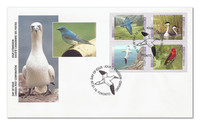| Name |
Value |
| Date of Issue |
January 10, 1997 |
| Year |
1997
|
| Quantity |
4,000,000 |
| Denomination |
45¢
|
| Perforation or Dimension |
12.5 x 13 |
| Series |
Birds of Canada
|
| Series Time Span |
1996 - 2001 |
| Printer |
Ashton-Potter Canada Limited. |
| Postal Administration |
Canada |
Use these values to track the value of your stamp collection?
prices in CAD
* Notes about these prices:
- They are not based on catalogue values but on current dealer and auction listings. The reason for this is that catalogues tend to over-value stamps.
- They are average prices. The actual value of your stamp may be slightly above or below the listed value, depending on the overall condition of your stamp. Use these prices as a guide to determine the approximate value of your stamps.
Pane of 20 Stamps
Quantity Produced -
Unknown
Official First Day Cover
Quantity Produced -
Unknown
Bird watching and stamp collecting are refined passions which, when practiced with patience and perseverance, give endless pleasure. These two great pastimes come together now in the latest edition of the series Birds of Canada. In 1996 the series began featuring images of Canadian birds with an issue of four domestic stamps (the pileated woodpecker, Atlantic puffin, ruby-throated hummingbird, and the American kestrel) and three types of postal stationery. The graceful and realistic renditions by artist Pierre Leduc were overwhelmingly popular with collectors around the world. Canada Post, therefore, takes great pleasure in announcing the 1997 issue of its Birds of Canada series. On the issue day of January 10th, stamp collectors and bird watchers will be thrilled by Pierre Leduc's newest artwork. The western grebe, mountain bluebird, northern gannet, and the scarlet tanager will be making their appearance on 45¢ stamps, and two pre-stamped envelopes will feature the western grebe and mountain bluebird. These birds have been selected with the advice of ornithologist Dr. Henri Ouellet to represent the various regions of Canada and a broad range of natural classifications. Most people living in and around the Gulf of St. Lawrence are familiar with the northern gannet (Morus bassanus). It's a large, fish-eating seabird which breeds in huge numbers on or in the steep sea cliffs of this region's many islands. The gannet is pure white except for the black tipped wings and the yellowish hue on its head. Often seen with gulls, the northern gannet is distinguished from them by a longer bill, head and neck, its sharply defined wings and generally more streamlined body. Unlike its scavenging friends, the gannet is a deft fisher. Its physique is adapted to diving from heights of 20 to 30 metres, entering the water head first, capturing fish and swallowing them whole. Northern gannets produce a single egg which is incubated over 44 days. The chick is fed with regurgitated food by its parents. After about 90 days the chick is ready to leave the nest in search of its own food. Although they are usually silent, the gannets will quarrel with loud, harsh warnings and complains to defend their nests during period of breeding. There are six colonies of northern gannets in Canada and about 70% of the North American breeding pairs can be found in the Gulf of St. Lawrence. The largest colony of 50,000 birds is on Ile Bonaventure, a wildlife sanctuary only a brief boat ride from Percé, Québec. Other colonies are found in and around the rocky shores of Newfoundland, including the Cape St. Mary's Seabird Ecological Reserve. This latter sanctuary is the only major seabird colony accessible by land. These gannets winter in the coastal waters from Florida to Virginia. It is a successful species that thrives in Iceland and the British Isles as well.
Designed by Raymond Bellemare. Based on a painting by Pierre Leduc.
Canada Post Corporation. Canada's Stamp Details, Vol. 6, No. 1, 1997, p. 5-6, 8-9.
Did you notice an error in this stamp's information?
Do you have any interesting information about this stamp that you would like to share?
Please
click here to send us an email with the details.


